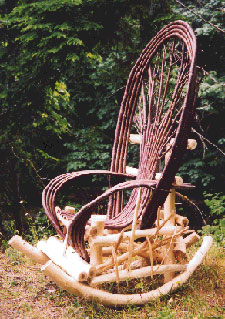
“Sticks and stones may break my bones,” goes the old playground chant, but in the hands of Tom Jahns, they become not only safe, but beautiful and comfortable besides. His free-form, organic designs become fully functional, and surprisingly comfortable, chairs, tables and beds made not from cut lumber, but from parts of trees and roots, sometimes paired with stones.
“I gather everything,” Tom told me, “and don’t buy anything but screws and glue.”

Tom spends hours make that days collecting the ingredients for his spectacular pieces. Sometimes, he spends hours looking for just one perfect element for a piece. A good example is the natural pair of matching hoof-shaped feet on “The Ancient One” chair. Having found a wonderful piece to use as a front foot, he had to spend hours searching for its mate. These are the touches that set his work apart.
Some of the results of good gathering are quite subtle, like the alternating mirror image forks on the back of his Destiny Chair. “What people see in my work is a wildness of natural form, but also a neatness and order to it. Even as a young man, I would go to mountain streams and move rocks to make the stream a bit neater.”
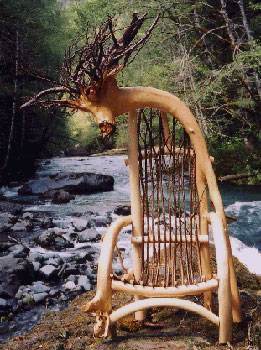
Collecting and building just the right ingredients is no small task. “The work is labor-intensive,” Jahns explained, “but I make a conscious effort not to be aware of time, either in gathering pieces that work together, or in assembly. I’d rather not know how long each piece takes to make. If I ever figure out how much I am making per hour, it would probably scare me off from what I do. I’m trying to feed my soul as well as my family, so I work a lot more than 40 hours per week, but I truly enjoy my work.”
“My favorite pieces to make are those of dug-up trees.” The pieces that look like clean, white driftwood are actually roots that he digs up. “I look for trees with character, and dig up the entire tree, often including rocks that are permanently embedded in the root. I do my collecting during the spring when the bark loosens, to allow me to peel the bark by hand. The tree must be live in order to be able to peel the bark, which leaves a very lustrous, subtly textured surface.”
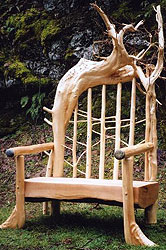
“Peeling the bark is just the first step. I have to scrub sap off several times, since the sap will mildew. Then the wood is left to dry and cure. I coat the ends and also the face that will be the front of the piece with waterbased urethane to prevent checking. Everything is air-dried.”
“My favorite pieces are the one-of-a-kind, dug-up ‘reaching for the light’ chairs,” Tom explained. “The character of the dug up tree determines the use of the piece. I am only part of the process, assembling the pieces based on the form they take. Sometimes, I’m rather surprised at the direction the piece ends up taking. I also like making beds a lot, because the head and footboards are like a blank canvas. With beds, I work with the customer and allow them to be part of the creative process.” The furniture itself is assembled by pre-drilling, countersinking and screwing each piece of wood with decking screws
Tom’s path to this unusual art and furniture form was hardly direct, but it did have its roots in an early background. “My father was a builder,” he told me, “so I grew up helping him build. I worked throughout my life as a carpenter and a stonemason, but always tried to avoid that as my life work.” For about a dozen years after graduating from college with degrees in English literature and philosophy, he published a weekly newspaper in Wisconsin and, in his spare time, built himself a stone house.
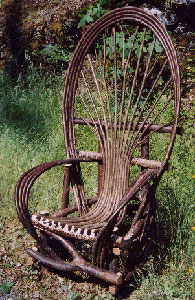
Eventually, he moved to the Pacific Northwest, where he built a forest home for himself, his wife and his six children on a piece of property on the Dosewallips River. Dosewallips is a Native American word meaning “the river that came forth from the mountain.” Once there, he took a job in the Olympic National Park at the environmental learning center of The Olympic Park Institute. He stayed there six years, during which he started making stick furniture to furnish his own house. Soon, he left his job and switched to making and selling his furniture full-time.
While each piece made from dug-up tree parts is, by its own order, different, some of his bent wood pieces are more repeatable. Tom’s bent wood pieces involve more control, but they, too, start with collected wood. According to Tom, such bent wood forms were originated by the Choctaw Indians of Kentucky.
“I like gathering young saplings, two to three years old,” Jahns explained. He bends the saplings while they are still green, and uses about 20 different varieties of wood. “I gather straight sections, and have learned to feel how they want to bend. The bending process involves moving it back and forth over my knee. I look for pieces with character and shape, such as forks and bends. These add movement and interest to each piece.”
Some of his more eye-catching chairs sport natural stone seats. “They must be comfortable as well as beautiful, so I look for stones that actually look like cushions. From there, I find wood pieces for backs such that the two fit together. The rock has to fit the back piece both for comfort and appearance. Once those are in place, I build the legs, which are carved to fit the bottom of the stone and glued in place with pure silicone. Hence, the weight of the stone is held by the front legs. The challenge is to make it beautiful, comfortable and strong all at the same time.”
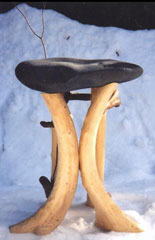
Blending work and art is a necessity for Tom, and is part of what he sees as the proper path to life. “I try not to divide life into compartments, such as work versus family. I see that all as one. Spirit is what we really are; that energy that makes up our mind and body. My mind, body and creative spirit must all be involved in a job for me to be happy. I get a lot of people telling me ‘you are so lucky to be an artist.’ To me, the definition of an artist is someone who does something well. The truth is, we are all artists. Everyone has something they do well.”
Clearly, this is one of the things Tom does exceptionally well.







